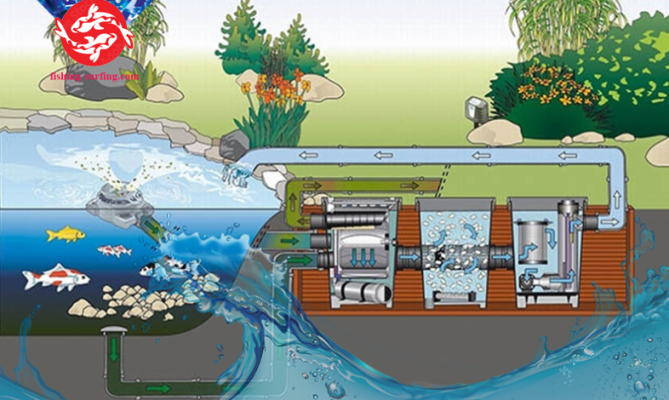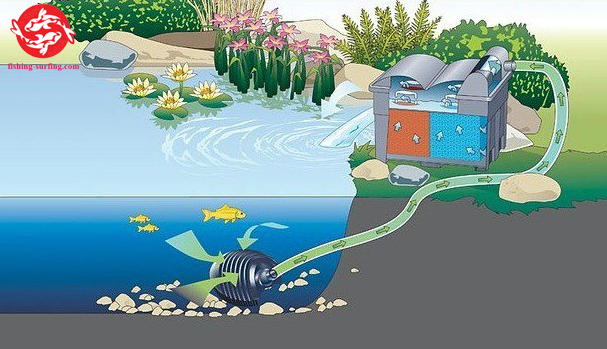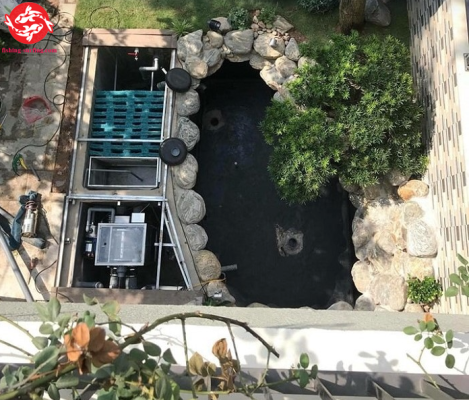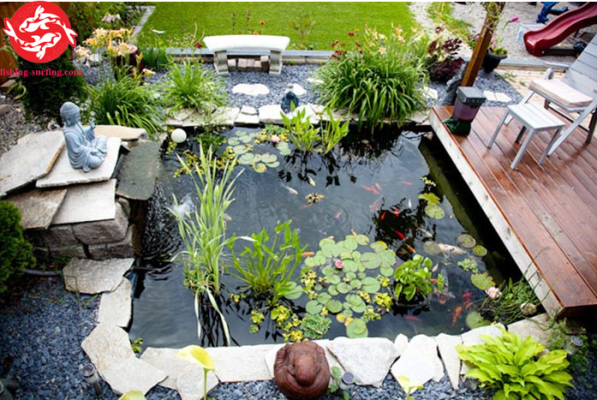Creating the best koi pond filtration system setup is essential for maintaining a healthy environment for your koi fish. A well-planned filtration system not only keeps the water clean but also ensures that your koi thrive in their aquatic home. From understanding the different types of filters to selecting the right components, this article will guide you through all the necessary steps to create an effective filtration system.
Understanding Koi Pond Filtration Systems

Before diving into the specifics of setting up your koi pond filtration system, it’s crucial to understand what a filtration system does. At its core, a filtration system removes waste, debris, and toxins from the water, providing a clean habitat for your koi. There are three main types of filtration: mechanical, biological, and chemical.
Mechanical Filtration
Mechanical filtration is the first stage of any effective koi pond filtration system setup. This process involves removing solids from the water, such as leaves, uneaten food, and fish waste.
The most common form of mechanical filtration comes in the shape of filter pads and screens that physically trap these particles. These materials need to be cleaned and replaced regularly to maintain efficiency.
A good mechanical filter can significantly reduce the load on your biological filter. By removing larger particles, the biological filter can focus on breaking down ammonia and nitrites produced by fish waste, thereby improving water quality.
Biological Filtration
Biological filtration is arguably the most important aspect of any koi pond filtration system. Unlike mechanical filtration, which physically removes waste, biological filtration relies on beneficial bacteria to break down harmful substances in the water.
These bacteria convert toxic ammonia, produced by fish waste, into less harmful nitrates through a process called nitrification. To effectively set up biological filtration, it’s essential to provide ample surface area through which these bacteria can colonize.
Using filter media like bio-balls or sponge filters enhances the capacity of your biological filter, promoting a thriving community of beneficial bacteria. Regular monitoring of water parameters will help you understand how your biological filter is performing and whether adjustments are necessary.
Chemical Filtration
Chemical filtration plays a supporting role in the overall filtration system. It utilizes various chemicals and compounds to remove impurities and contaminants that are not eliminated through mechanical or biological means.
Activated carbon is one of the most popular options in chemical filtration. It absorbs pollutants, discoloration, and odors, resulting in crystal-clear water. However, it’s worth noting that while activated carbon is effective, it does require routine replacement.
So, in summary, the best koi pond filtration system setup should incorporate all three types of filtration—mechanical, biological, and chemical—to create a balanced and healthy aquatic environment for your koi.

Choosing the Right Filtration Components
Now that you understand the different types of filtration, the next step is selecting the right components for your koi pond filtration system setup.
Pond Size and Stocking Density
The size of your pond and the number of koi fish you plan to keep will significantly influence your selection of filtration components. Larger ponds or those with a higher fish density require robust filtration systems to handle the increased bio-load.
When determining the appropriate size of the filtration system, consider factors like the volume of water, stocking density, and the type of koi you have. As a general rule, aim for a filtration system that can process the entire volume of water in your pond at least once per hour.
Types of Filters Available
There are several types of filters available for koi ponds, each serving specific needs:
- Pressure Filters: These are versatile and efficient, suitable for both small and large ponds. They offer mechanical, biological, and even UV sterilization in a single unit.
- Gravity Filters: Gravity filters are often used in larger setups, where water flows by gravity into the filter. They usually require more maintenance but can handle larger amounts of waste effectively.
- Skimmer Filters: These filters remove debris from the pond’s surface before they sink. They are excellent for keeping the top of the water clean but should be paired with other filtration types for comprehensive coverage.
Each type has its pros and cons. For example, pressure filters tend to be easier to maintain, while gravity filters may require more space and technical knowledge.
Flow Rate Considerations
Flow rate is another critical factor when choosing filtration components. The pump must be able to move water efficiently through the filtration system without creating excessive turbulence in the pond.
To calculate the ideal flow rate, consider the volume of your pond and the desired turnover rate. You may need to experiment with different pumps and settings until you achieve the perfect balance between adequate filtration and gentle water movement.
By carefully selecting the right components based on these criteria, you can ensure that your koi pond filtration system setup meets the unique needs of your aquatic environment.

Installation Process for Your Filtration System
Once you’ve selected your filtration components, the next step is the installation process. Setting up a koi pond filtration system may seem daunting, but with careful planning and execution, it can be done efficiently.
Preparing the Site
Before any installation begins, ensure that the area around your pond is clean and free of debris. A clutter-free site allows for easier access during the installation process.
Next, decide on the optimal location for your filtration system. Ideally, the filter should be placed near the pond but not directly in the water. This arrangement helps to minimize the length of plumbing required and makes maintenance simpler.
Connecting the Plumbing
After preparing the site, it’s time to connect the plumbing to the filtration components. Use high-quality PVC pipes or flexible tubing designed for outdoor use. Ensure all connections are secure to prevent leaks.
When designing the plumbing layout, think about how the water will flow through the system. Water typically flows from the pond to the skimmer, then to the filter, and back to the pond via a return line. Use fittings that allow for easy disassembly so you can perform maintenance whenever necessary.
Final Touches and Testing
Once all connections are made, fill your pond with water and run the filtration system to test it. Look for any signs of leaks and ensure that water flows smoothly through the system. Monitor the water level and quality for the next few days to identify any issues early on.
If everything works as expected, add your koi to the pond after adjusting water conditions to ensure a safe environment. It is advisable to introduce fish gradually to allow your filtration system to acclimate to the new bio-load.
With all these steps followed, you’ll have successfully set up the best koi pond filtration system

Maintenance of Your Filtration System
An effective koi pond filtration system requires regular maintenance to function optimally. Regular upkeep ensures that your koi remain healthy and your pond stays beautiful.
Cleaning Mechanical Filters
Mechanical filters will accumulate debris over time and require periodic cleaning. Depending on the amount of waste generated in your pond, you may need to clean these filters every few weeks or months.
To clean, simply remove the filter pads or screens and rinse them under fresh water. Avoid using soap or chemicals, as they can harm the beneficial bacteria in your biological filter. If they’re particularly clogged, you may need to replace them entirely.
Monitoring Biological Filters
While biological filters are generally low-maintenance, it’s essential to monitor the health of the beneficial bacteria. Conduct regular water tests to check levels of ammonia, nitrite, and nitrate.
In cases of sudden spikes in ammonia or nitrites, you may need to temporarily halt feeding your fish, as excess waste can overwhelm the biological filter. Adding aeration can also help boost oxygen levels, facilitating bacterial growth.
Assessing Chemical Media
As previously mentioned, chemical filtration media like activated carbon needs regular replacement. Each brand may have specific guidelines on how often to change it based on usage and water quality.
Pay attention to the clarity and condition of your water. If you notice unusual discoloration or odors, it may be time to replace your activated carbon or other chemical media.
Regular maintenance checks will ultimately contribute to the longevity of your koi pond filtration system setup, ensuring that your koi live happily and healthily.
FAQs
What is the best koi pond filtration system?
The best koi pond filtration system typically combines mechanical, biological, and chemical filtration methods to create a balanced and healthy ecosystem. Selecting appropriate components tailored to your pond size and stocking density is crucial.
How often should I clean my koi pond filters?
Mechanical filters should be cleaned every few weeks or months, depending on the amount of debris in your pond. Monitor water quality closely and adjust cleaning schedules as needed.
Can I have too much filtration in my koi pond?
While effective filtration is essential, too much filtration can disturb the natural habitat for your koi. Excessive water movement can make it difficult for koi to swim comfortably. Aim for a balance that promotes good water quality while allowing for a serene environment.
Is a UV filter necessary for a koi pond?
UV filters are not strictly necessary, but they can be beneficial in controlling algae and improving water clarity. Incorporating a UV sterilizer into your filtration system can help tackle issues related to green water.
How do I know if my filtration system is working properly?
Routine checks on water quality parameters such as ammonia, nitrite, and nitrate levels will indicate the effectiveness of your filtration system. Any sudden changes in water quality may necessitate adjustments or repairs.
Conclusion
Setting up the best koi pond filtration system setup involves careful planning, selecting the right components, and maintaining the system. Understanding the importance of mechanical, biological, and chemical filtration is crucial for creating a thriving environment for your koi. Regular maintenance ensures that your pond remains healthy and aesthetically pleasing, enriching your experience as a koi keeper. Take the time to educate yourself, invest in quality equipment, and enjoy watching your koi flourish in their beautifully filtered home.

